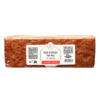
In January, many of us are starting to think about cutting down after a touch of festive indulgence. But over on the other side of the Channel, January is one of the most exciting months of the year in the French food calendar. It’s a time when almost every bakery in the country starts selling a very special, delicious dessert that could make you King or Queen for the day!
Galette de rois, or “Kings’ cake”, is the traditional sweet treat shared between family members at Epiphany on January 6th. It’s said to represent the three Kings being led to visit the new baby Jesus.
What is galette de rois?
A galette is a flat French cake or pie that often comes with a variety of fillings. However, unlike a fruit galette which includes a layer of fruit jam, galette de rois contains a sweet almond-based frangipane cream. It’s spread between two layers of very flaky puff pastry, and baked in the oven until golden.
This is the classic version that’s enjoyed in abundance across many parts of northern France. But down in the south, there’s a different version that’s just as tasty. This southern alternative is made from a sweet and sticky round brioche, soaked in orange blossom and topped with candied fruits. In Provence, it’s known as ‘brioche des rois’, but different regions use different names.
The only way to know for sure which version is better is to sample both! At BonneBouffe, we sell a wide range of French food online, including fresh puff pastry, to help you whip up your own treats for Epiphany. But there’s one additional thing no galette de rois is complete without: a fève.


Finding the fève
What’s the secret ingredient that makes galette de rois so special? The fève. Tradition has it that every galette de rois is made with a small trinket hidden inside the filling, before the cake is baked.
When the cake is sliced and shared, the lucky guest who finds the fève becomes King or Queen for the day. And it’s tradition to wear a paper crown to show off royal status. Historically, the fève was a small statue of the baby Jesus. The ‘King’ would find Christ just like the three Kings are said to have done.
Over the years, the fève has changed a bit. Sometimes, a religious figure is still used. Other times, it’s a more contemporary famous figure, or even a child’s toy. Whatever it is, finding the fève is a pretty big deal. There are even some people who see it as a competition, collecting fèves from all over!
Say ‘yes’ to French delicacies
This January, why not take a slice out of French life and celebrate good times, and good food? You can also use this as an opportunity to try out a few other traditional French sweet treats, from almond and calisson cake to beautifully delicate nougat. The choices are practically endless.




 Please fill the form below for one of our team to contact you
Please fill the form below for one of our team to contact you